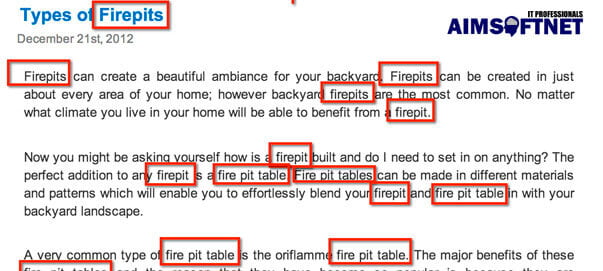In this article we’ll examine the top 5 black hat SEO techniques in a bid to help you determine whether the SEO firm you’re currently using are potentially compromising your business website. Then we’ll examine the top 5 white hat SEO techniques that we believe will have a positive effect on your search position without putting your business website at risk.
TOP 5 BLACK HAT SEO TECHNIQUES
1. Hidden Content
Top of our list of black hat SEO techniques is hidden content. Hidden content comes in many guises but the basic principle is that within the code for the site there will be content stuffed with keywords, this content will not be visible to the end user of the site.
One way of doing this is by using comment tags.
Comment tags look like this;
<!– Comment Tag –>
The real purpose of comment tags is for developers to add in useful reminders within their code explaining what that piece of code does.
Here’s an example of the comment tag being used correctly,
<!– Start of the Main Content –>
Here’s an example of a comment tag being used incorrectly in a bid to promote a hypothetical page targeting search engine optimisation,
<!—Search engine optimisation, SEO, professional search engine optimisation company, spamming search engines –->
Another popular way of hiding content is the use of the <noscript> tag. The <noscript> tag should be used to inform a user that a script is being used but their browser either doesn’t support the script
language used or they have that function turned off.
Here’s an example of the <noscript> tag being used correctly,
<script type=”text/javascript”> <!– document.write(“Hello World!”) //–> </script><br />
<noscript>Your browser does not support JavaScript!</noscript>
Here’s an example of the <noscript> tag being used as a black hat SEO technique again in a bid to promote a hypothetical page but this time targeting car hire,
<noscript> Imaginary Car Hire Firm do Car Hire which is very affordable so if you want to hire a car call our car hire firm because we are the best car hire firm in the world </noscript>
Other HMTL tags misused in similar ways include the <noframes> tag and hidden inputs in forms.
Content can also be hidden from the end user by using CSS, excessively small text and colored text on the same coloured background.
All of these techniques are frowned upon by search engines and if detected can mean your website will be penalized or even banned. To the untrained eye it can be very difficult to spot the use of some of these techniques which is why we offer a free website MOT test at Push ON.
2. Meta Keyword Stuffing
There are two Meta tags that are generally used to inform search engines of the content on the page. They reside between the <head> tag of a page and when used incorrectly they can alert a search engine that a site is using spam techniques in an attempt to improve its ranking.
Meta Description
The meta description should be used to describe the content of your page honestly and concisely and be 1 or 2 sentences, 3 at most.
Here’s an example of the meta description being used in the correct manner,
<meta name=”description” content=”PushON are an Online Marketing agency providing a full range of digital marketing services throughout Greater Manchester and the North West UK. If you need Search Engine marketing (SEM), Search Engine Optimisation (SEO) or Pay per Click (PPC), we can help you. Contact us now.” />
Here’s an example of the meta description tag being used incorrectly for a page promoting a restaurant called “MadeUp”,
<meta name=”description” content=”MadeUp restaurant website is the best MadeUp restaurant website, our restaurant is better than any restaurant,great restaurant,best food restaurant,visit our restaurant” />

3. Duplicate Content
Not only is copying plagiarism, the search engines will catch the copies and deindex the pages. There is no advantage to a search engine to list many sites with the same content.
When all the sites listed in a search result are exactly alike, it is frustrating. No one wants to sort through many sites only to find the same content over and over again.
Focus on content marketing and stick to relative valuable content.
4. Link Exchanges
Link exchanges may sound like an excellent link building idea. Suppose two website owners agreed to link back to each other’s site.
Site owners want to create relevant links to each site which did not exist before. This is a simple link exchange. While it is possible to do this properly, often, the result is a long list of links.
As friendly as this may sound, it is not helpful to the people who visit the sites. The long lists of links often are not relevant to the other content on the website. Besides, lists of links are hard to sort through.
5. Hidden Text and Links
Keyword stuffing is not the only way to be sneaky with keywords. Often, site owners get the idea to keep their sites readable by humans but want to add extra keywords or links anyway. Usually, these extra keywords do not make sense on the site, so website owners hide them from the readers.
Websites can hide keywords and links by making the text the same color as the background. No one reading the site can see the hidden links and text. The search engine spiders can see them and count these as part of the site.
This might temporarily allow the listing with hidden keywords. When this happens, the search results are no longer useful. A human searcher gets a website with no relation to the words searched.





